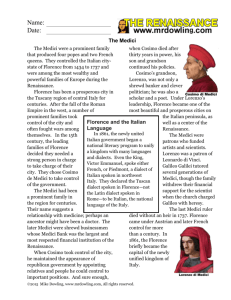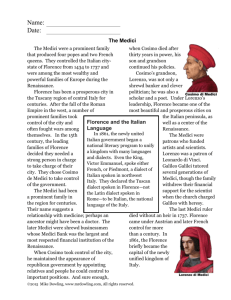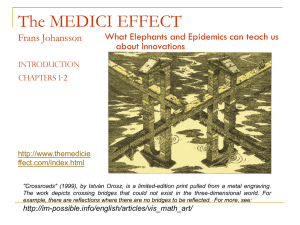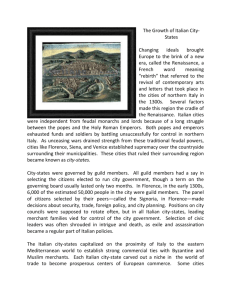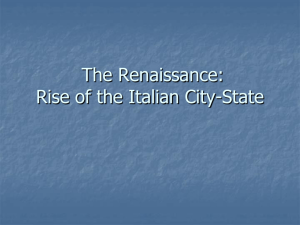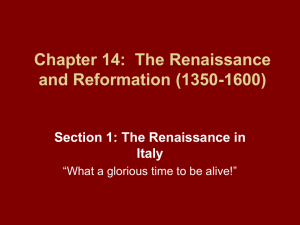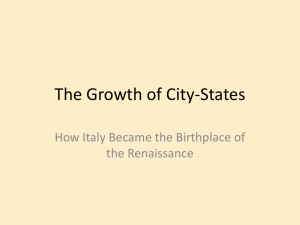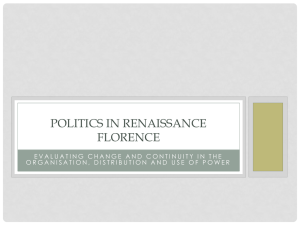BIRTH OF THE MEDICI DYNASTY The Medici story began around
advertisement
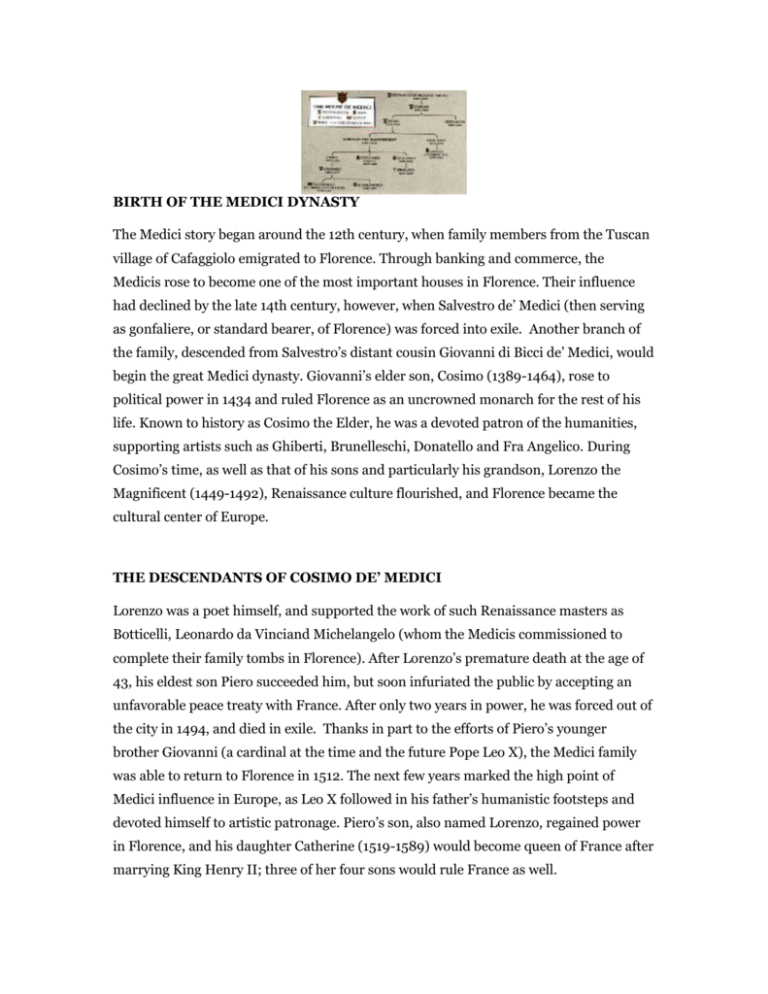
BIRTH OF THE MEDICI DYNASTY The Medici story began around the 12th century, when family members from the Tuscan village of Cafaggiolo emigrated to Florence. Through banking and commerce, the Medicis rose to become one of the most important houses in Florence. Their influence had declined by the late 14th century, however, when Salvestro de’ Medici (then serving as gonfaliere, or standard bearer, of Florence) was forced into exile. Another branch of the family, descended from Salvestro’s distant cousin Giovanni di Bicci de’ Medici, would begin the great Medici dynasty. Giovanni’s elder son, Cosimo (1389-1464), rose to political power in 1434 and ruled Florence as an uncrowned monarch for the rest of his life. Known to history as Cosimo the Elder, he was a devoted patron of the humanities, supporting artists such as Ghiberti, Brunelleschi, Donatello and Fra Angelico. During Cosimo’s time, as well as that of his sons and particularly his grandson, Lorenzo the Magnificent (1449-1492), Renaissance culture flourished, and Florence became the cultural center of Europe. THE DESCENDANTS OF COSIMO DE’ MEDICI Lorenzo was a poet himself, and supported the work of such Renaissance masters as Botticelli, Leonardo da Vinciand Michelangelo (whom the Medicis commissioned to complete their family tombs in Florence). After Lorenzo’s premature death at the age of 43, his eldest son Piero succeeded him, but soon infuriated the public by accepting an unfavorable peace treaty with France. After only two years in power, he was forced out of the city in 1494, and died in exile. Thanks in part to the efforts of Piero’s younger brother Giovanni (a cardinal at the time and the future Pope Leo X), the Medici family was able to return to Florence in 1512. The next few years marked the high point of Medici influence in Europe, as Leo X followed in his father’s humanistic footsteps and devoted himself to artistic patronage. Piero’s son, also named Lorenzo, regained power in Florence, and his daughter Catherine (1519-1589) would become queen of France after marrying King Henry II; three of her four sons would rule France as well. A NEW MEDICI BRANCH COMES TO POWER By the early 1520s, few descendants of Cosimo the Elder remained. Giulio de’ Medici, the illegitimate son of Lorenzo the Magnificent’s brother Giuliano, abdicated power in 1523 to become Pope Clement VII, and the short and brutal rule of Alessandro (reputed to be Giulio’s own illegitimate son) ended with his assassination in 1537. At this point, the descendants of Cosimo the Elder’s brother (known as Lorenzo the Elder) came forward to launch a new Medici dynasty. Lorenzo’s great-great-grandson Cosimo (1519-1574) became duke of Florence in 1537, then grand duke of Tuscany in 1569. As Cosimo I, he established absolute power in the region, and his descendants would rule as grand dukes into the 1700s. Cosimo’s elder son Francis succeeded his father, but proved a less effective ruler. His daughter Marie would become queen of France when she married Henry IV in 1600; her son would rule as Louis XIII from 1610-43. Francis’ younger brother Ferdinand, who became grand duke in 1587, restored Tuscany to stability and prosperity. He also founded the Villa Medici at Rome and brought many priceless works of art to Florence. THE MEDICI DYNASTY IN DECLINE In general, the later Medici line renounced the older generation’s republican sympathies and established more authoritarian rule, a change that produced stability in Florence and Tuscany but led to the region’s decline as a cultural hub. After Ferdinand’s son Cosimo II (who supported the work of the mathematician, philosopher and astronomer Galileo Galilei) died in 1720, Florence and Tuscany suffered under ineffectual Medici rule. When the last Medici grand duke, Gian Gastone, died without a male heir in 1737, the family dynasty died with him. By agreement of the European powers (Austria, France, England and the Netherlands), control over Tuscany passed to Francis of Lorraine, whose marriage to Hapsburg heiress Maria Theresa of Austria would begin the long European reign of the Hapsburg-Lorraine family.
